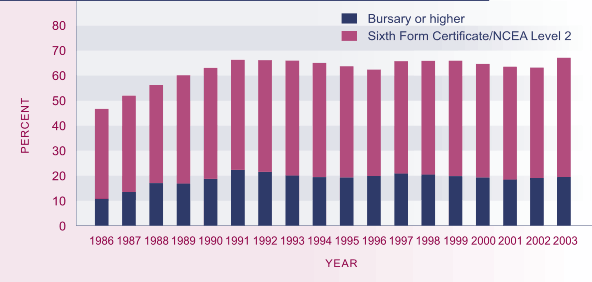School leavers with higher qualifications
Definition
The proportion of secondary school leavers who leave school with qualifications
higher than National Certificate of Educational Attainment (NCEA) Level 1.
These include Sixth Form Certificate, NCEA Level 2, Higher School Certificate,
Entrance Qualification and University Bursary.
Relevance
Upper secondary education serves as the foundation for higher
(post-secondary) learning and training opportunities as well as preparation
for direct entry into the labour market. Those who leave school early with
few qualifications are at a much greater risk of unemployment or vulnerability
in the labour force and of having low incomes.39
Current level and trends
In 2003, 67 percent of school leavers (36,000) left school
with qualifications higher than NCEA Level 1, an increase from 63 percent
in 2002. The proportion of school leavers with at least Sixth Form Certificate
or NCEA Level
2 qualifications has increased considerably from 47 percent in 1986. However,
most of the increase occurred in the late 1980s. Since 1990, the proportion
has fluctuated between 63 percent and 67 percent.
The proportion of school leavers attaining an A or B Bursary or Scholarship
also increased during the period 1986–1991 and has remained around 18–22 percent
over the past decade. In 2003, 20 percent of school leavers (10,500) had attained
an A or B Bursary, an increase from 19 percent in 2002.
The lack of sustained growth in the proportion of school leavers with
higher qualifications since the early 1990s may be explained, in part, by an
increase in employment and training opportunities for those without higher
qualifications.
Figure K2.1 Proportion of school leavers with higher qualifications, 1986–2003

Source: Ministry of Education
Notes: [1] Bursary or higher includes: A or B Bursary, Scholarship (to 1989)
and National Certificate Level 3 or above (from 1996) [2] Sixth Form Certificate/NCEA
Level 2 includes Higher School Certificate
and Entrance Qualification
Sex differences
In 2003, 71 percent of female school leavers had qualifications
higher than NCEA Level 1, compared to 63 percent of males. Between 1986 and
2003 the proportion of school leavers with at least Sixth Form Certificate/NCEA
Level 2 or Bursary improved at a faster rate for females than for males.
Table K2.1 Proportion (%) of school leavers with higher qualifications,
by sex, selected years, 1986–2003
| |
Sixth Form Certificate/
NCEA Level 2 or higher |
Bursary or higher |
| |
Male |
Female |
Male |
Female |
| 1986 |
45.2 |
48.1 |
11.6 |
10.0 |
| 1991 |
63.5 |
69.2 |
21.1 |
23.4 |
| 1996 |
59.0 |
66.5 |
17.8 |
22.0 |
| 2001 |
59.4 |
68.1 |
15.8 |
21.2 |
| 2002 |
59.0 |
67.6 |
16.7 |
21.5 |
| 2003 |
63.2 |
71.2 |
17.5 |
21.9 |
Source: Ministry of Education
Notes: [1] Bursary or higher includes: A or B Bursary, Scholarship (to 1989)
and National Certificate Level 3 or above (from 1996) [2] Sixth Form Certificate/NCEA
Level 2 or higher includes. Higher School Certificate
and Entrance Qualification
Ethnic differences
The proportion of Māori
school leavers with qualifications higher than NCEA Level 1 increased sharply
between 2002 and 2003, from 39 percent to 45 percent. Among Pacific school
leavers, the proportion with higher qualifications increased from 54 percent
in 2002 to 59 percent in 2003. However, these improved outcomes for Māori and Pacific students had little effect on ethnic differences in school attainment
because there were also increases in the proportion of European and Asian school
leavers with higher qualifications between 2002 and 2003 (from 68 to 72 percent
for Europeans and from 84 to 86 percent for Asians).
There is also a substantial difference between ethnic groups in the proportions
leaving school with Bursary or similar higher qualifications. In 2003, 4 percent
of Māori and Pacific school leavers gained an A or B Bursary or National Certificate
at Level 3 or above, compared with 23 percent of European and 42 percent of
Asian school leavers. There has been little change in these proportions over
the decade to 2003.
Table K2.2 Proportion (%) of school leavers with higher qualifications
by ethnic group,
selected years, 1991–2003
| |
European |
Māori |
Pacific |
Asian |
Other |
Total |
Sixth Form
Certificate/
NCEA Level 2 or higher |
|
|
|
|
|
|
| 1991 |
na |
37.4 |
52.2 |
na |
na |
66.3 |
| 1996 |
68.9 |
37.4 |
53.7 |
81.5 |
60.0 |
62.7 |
| 2001 |
68.5 |
40.6 |
54.7 |
84.7 |
63.7 |
63.6 |
| 2002 |
68.4 |
38.9 |
53.5 |
84.4 |
67.7 |
63.3 |
| 2003 |
71.6 |
45.0 |
58.9 |
86.4 |
70.7 |
67.1 |
| Bursary or
higher |
|
|
|
|
|
|
| 1991 |
na |
5.1 |
7.4 |
na |
na |
22.3 |
| 1996 |
23.7 |
4.1 |
5.8 |
41.7 |
18.8 |
19.9 |
| 2001 |
21.2 |
4.0 |
4.7 |
42.2 |
20.5 |
18.4 |
| 2002 |
22.2 |
3.9 |
4.2 |
41.3 |
21.1 |
19.1 |
| 2003 |
22.7 |
4.5 |
4.4 |
41.9 |
20.4 |
19.7 |
Source: Ministry of Education
Notes: [1] Bursary or higher includes: A or B Bursary, Scholarship (to 1989)
and National Certificate Level 3 or above (from 1996) [2] Sixth Form Certificate/NCEA
Level 2 or higher includes. Higher School Certificate and Entrance Qualification
Socio-economic differences
Young people from schools that draw their students
from low socio-economic communities are less likely than other young people
to attain higher school qualifications. In 2003, only 52 percent of school
leavers from decile 1–3 schools (in the most disadvantaged communities) attained NCEA Level
2 or higher qualifications, compared with 64 percent of those leaving decile
4–7 schools and 79 percent of those leaving decile 8–10 schools.
|

